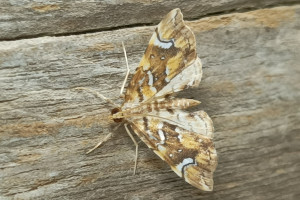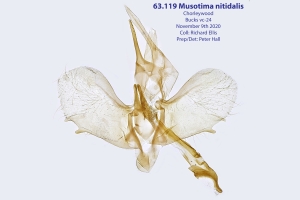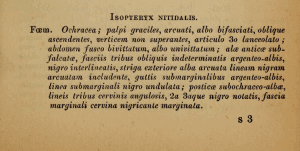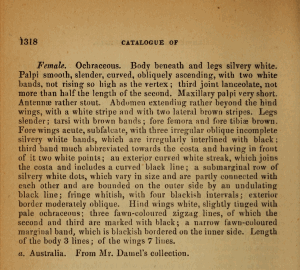

 +7Kontinente:EUOC
+7Kontinente:EUOC2. Diagnose
2.1. Genitalien
2.1.1. Männchen
2.2. Erstbeschreibung
3. Biologie
3.1. Nahrung der Raupe
- [Pteridaceae:] Adiantum aethiopicum
- [Pteridaceae:] Adiantum sp.
- [Pteridaceae:] Pteridium esculentum
- [Dennstaedtiaceae:] Histiopteris incisia
Anderson & Cannon (2011) listen außereuropäische Nahrungspflanzen auf, die allerdings auch Verwandte in Europa haben: "Known hosts are: Adiantum spp. (maidenhair ferns): inc. Adiantum aethiopicum; Histiopteris incisia; Pteridium esculentum and possibly other ferns of the family Pteridaceae." Wahrscheinlich wurde die Art mit Transporten von Baumfarnen aus Australasien nach England eingeschleppt.
4. Weitere Informationen
4.1. Andere Kombinationen
- Isopteryx nitidalis Walker, [1866] [Originalkombination]
4.2. Synonyme
- Diathrausta timaralis R. Felder & Rogenhofer, 1875
4.3. Faunistik
Anderson & Cannon (2011) veröffentlichen am 12. Dezember 2011 im Auftrag von "The Food and Environment Research Agency" der englischen Regierung ein "Rapid assessment of the need for a detailed Pest Risk Analysis for Musotima nitidalis. Sie begründen ihren Artikel: "What is the reason for the rapid assessment? This moth is a pest of ferns. It was first trapped in the UK in Hampshire by amateur moth recorders in 2009 and it is likely that it entered the UK in association with tree ferns. After the first finding it was agreed that no action should be taken, but to keep a look out for further interceptions. This rapid assessment was initiated following the second finding, in October 2011 in West Sussex, to help inform the decision on whether statutory action is justified against future interceptions." Sie fragen weiter: "Is the pest established or transient, or suspected to be established/transient in the UK? The first UK finding of this pest occurred in November 2009, when a specimen was captured on a moth trap at a nature reserve near Bournemouth Airport. Subsequently a second specimen was trapped on 26th October 2011 in Crawley Down, West Sussex. Both specimens found were adults, and both were trapped on light traps set up by amateur moth recorders. Although these may be transient, it is also possible that this moth has naturalised in small numbers." Die Autoren machen sich Gedanken über eine mögliche Ansiedlung in England und stellen fest, dass sowohl der Adlerfarn (Pteridium aquilinum) als auch der Schwarzstielige Streifenfarn (Asplenium adiantum-nigrum [= Adiantum adiantum-nigrum]) als weit verbreitete Arten als Nahrungspflanzen in England in Frage kämen. Die Autoren überlegen: "How likely is the pest to establish outdoors or under protection in the UK? Evidence from trapping of the moth suggests that either transients are surviving or it may already be naturalised outdoors in the southern part of the UK. Its presence in southeastern Australia and southern New Zealand, areas with a similar climate to southern UK, suggests that the UK climate is suitable for establishment."
Auf UKmoths [UKmoths, abgefragt 14. November 2014] war zur Art zu lesen: "Adventive. This species was first found in Dorset in 2009, and since then there have been quite a number of records scattered in the southern counties between Dorset and Essex. Some locations have had multiple occurrences suggesting that it may now be resident in these areas. It is native to Australia and New Zealand and is suspected to have originally been imported with tree ferns." [Den zugehörigen Artikel in Atropos, Vol. 50 (September 2013) konnte ich noch nicht einsehen.]
Auf Hantsmoths [hantsmoths.org.uk, abgefragt 6.12.2015] heißt es zur Art: "First trapped at Merritown Heath, Dorset on 11 August 2009 by Mike Jeffes and David Evans, and identified at the BENHS Exhibition that year by Martin Honey (BMNH) as the present species, a native of New Zealand which feeds on various fern species. Certainly introduced by the horticultural trade, it has since spread widely, with multiple sightings from other sites close to the original trapping location and in Hurn Forest (in Dorset, but in the VC11 South Hampshire vice-county), but also as far as East and West Sussex, and Harlow in Essex."
Auf [birdguides.com] wird ein Falter aus Harlow (Essex) mit Datum 14. November 2012 gezeigt.
Auf der Seite der Sussexmothgroup [sussexmothgroup.org.uk, abgefragt 6.12.2015] finden sich Falter-Bilder vom 21. August 2013 (Wych Cross), 19. Oktober 2013 (Wych Cross) und 24. Oktober 2014 (Crowborough).
Wir müssen also weiterhin mit der Art in England rechnen - und sicher doch auch bald im Rest Europas. Alleine auf iNaturalist finden sich 48 Meldungen ([inaturalist.org, abgefragt 29.12.2023]) aus dem Südosten Englands die eine Bodenständigkeit nahelegen.
Bereits 2021 wurden 2 Exemplare in den Niederlanden gefangen und 2023 erfolgte dann scheinbar ein größerer Einflug, wohl aus England, da sämtliche Funde überwiegend im Küstenbereich erfolgten ([waarneeming.nl, abgefragt 29.12.2023]).
Und tatsächlich: Am 15. August 2022 fotografierte Thomas Huet in Clitourps im Département Manche - also nur rund 6 km vom Ärmelkanal entfernt - den ersten Falter in Frankreich (siehe [Artseite auf oreina.org/artemisiae]).
Und am 26. Oktober 2023 teilte uns Chris Steeman per e-Mail mit, dass 2023 2 Exemplare im Küstenbereich von West-Vlaanderen in Belgien gefunden wurden.
(Autor: Erwin Rennwald)
4.4. Literatur
- Anderson, H. & R. Cannon (2011): Rapid assessment of the need for a detailed Pest Risk Analysis for Musotima nitidalis [PDF auf defra.gov.uk].
- Erstbeschreibung: Walker, F. (1866) ["1865"]: List of the Specimens of Lepidopterous Insects in the Collection of the British Museum 34 (= Supplement 4): 1121-1533. London.












